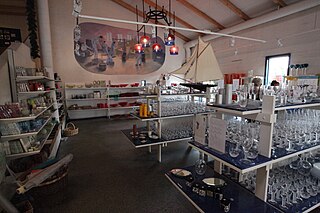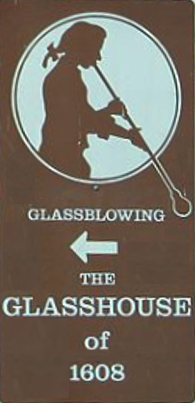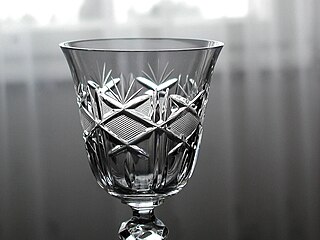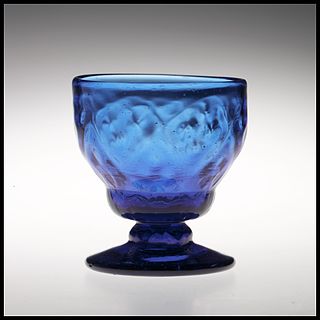
Murano is a series of islands linked by bridges in the Venetian Lagoon, northern Italy. It lies about 1.5 km (1 mi) north of Venice and measures about 1.5 km (1 mi) across with a population of just over 5,000. It is famous for its glass making. It was once an independent comune, but is now a frazione of the comune of Venice.

Glassblowing is a glassforming technique that involves inflating molten glass into a bubble with the aid of a blowpipe. A person who blows glass is called a glassblower, glassmith, or gaffer. A lampworker manipulates glass with the use of a torch on a smaller scale, such as in producing precision laboratory glassware out of borosilicate glass.

Uranium glass is glass which has had uranium, usually in oxide diuranate form, added to a glass mix before melting for colouration. The proportion usually varies from trace levels to about 2% uranium by weight, although some 20th-century pieces were made with up to 25% uranium.
Lalique is a French luxury glassmaker, founded by renowned glassmaker and jeweller René Lalique in 1888. Lalique is best known for producing glass art, including perfume bottles, vases, and hood ornaments during the early twentieth century. Following the death of René, Lalique transitioned to producing lead glass (crystal) works during the 1950s while under the direction of René's son, Marc Lalique. In 2010, Lalique was purchased by a Swiss company named Art & Fragrance SA, now known as Lalique Group SA.

Baccarat is a French luxury house and manufacturer of fine crystal located in Baccarat, Meurthe-et-Moselle, France. The company owns two museums: the Musée Baccarat in Baccarat, and the Musée Baccarat in Paris on the Place des États-Unis.

Kořenov is a municipality and village in Jablonec nad Nisou District in the Liberec Region of the Czech Republic. It has about 1,000 inhabitants. It lies in the Jizera Mountains.

Iittala, founded as a glassworks in 1881, is a Finnish design brand specialising in design objects, tableware and cookware. Iittala's official i-logo was designed by Timo Sarpaneva in 1956.

Bohemian glass, also referred to as Bohemia crystal, is glass produced in the regions of Bohemia and Silesia, now parts of the Czech Republic. It has a centuries long history of being internationally recognised for its high quality, craftsmanship, beauty and often innovative designs. Hand-cut, engraved, blown and painted decorative glassware ranging from champagne flutes to enormous chandeliers, ornaments, figurines and other glass items are among the best known Czech exports and immensely popular as tourist souvenirs. The Czech Republic is home to numerous glass studios and schools attended by local and foreign students.

Arc Holdings is the holding company of the Arc Group, specializing in the design and manufacturing of glass tableware. The Arc Group markets its collections in France and exports them abroad under the registered trademarks Luminarc, Arcopal, Cristal d’Arques Paris, Arcoroc and Chef&Sommelier. It also designs products for the private label and B2B markets.
Grönvik glasbruk or simply Grönvik was a glassworks in the present-day Grönvik village in Korsholm, Western Finland. It was founded by merchant Johan Grönberg and existed from 1812 to 1907. Several glass manufactures were produced at Grönvik. At first bottles and drinking-glass were made here, but beginning in the 1890s solely window glass. Also pharmaceutical glass was manufactured. The glassworks produced as the first factory in Finland pressed glass, which came about from the 1840s. The domestic market for glass was during the time of the glassworks smallish and glassblowing products were exported to e.g. Lübeck, Saint Petersburg, Stockholm and Denmark, as well as to other parts of Europe. Grönvik was able to successfully assert its position, despite the competition from other glassworks in Finland. Eventually, it became the most distinguished in the country. The glassworks also become the largest in the Nordic countries.

Maximilian Josef Riedel is an Austrian glassmaker and businessman. Born in Vienna, he is the 11th-generation CEO and President of Riedel, a glassware manufacturer established in 1756 and best known for its production of grape variety-specific glassware. Riedel is best known for designing the world's first variety-specific stemless wine glasses in 2004, expanding the company to international markets, and developing double-decanting technology.

Magnor Glassworks is a glass company located in Eidskog, in Hedmark county, Norway.

Early glassmaking in the United States began in Colonial America in 1608 at the Colony of Virginia near Jamestown, believed to be the first industrial facility in what would later become the United States. For centuries, glassmaking procedures, techniques, and recipes were kept secret, with countries actively preventing glassmaking knowledge from spreading beyond their borders. German workers with glassmaking knowledge, described as Dutchmen, along with Polish glass workers, were brought to Colonial America to begin operations. Although glass was made at Jamestown, production was soon suspended because of strife in the colony. A second attempt at Jamestown also failed.
J. H. Hobbs, Brockunier and Company was one of the largest and best-known manufacturers of glass in the United States during the 19th century. Its products were distributed worldwide. The company is responsible for one of the greatest innovations in American glassmaking—an improved formula for lime glass that enabled American glass manufacturers to produce high-quality glass at a lower cost. The firm also developed talented glassmakers that started glass factories in Ohio and Indiana.
Claus Josef Riedel was a Czech glassmaker, businessman, professor of chemistry, and chemical engineer. He was the 9th-generation owner of Riedel Crystal, an Austrian glassware manufacturer that was established in 1756. Riedel is best known for creating and producing grape variety-specific glassware designed to enhance types of wines based on specific properties of individual grape varieties. He was among the first glassware experts in history to recognize that the taste of wine is affected by the shape of the glass from which it is consumed, and is credited with first discovering the concept of variety-specificity in glassware, developing variety-specific glassware shapes and bringing these glasses to the consumer market. Riedel served as President and Chief Executive Officer of Riedel Crystal from 1957 until 1994.
Georg Josef Riedel is an Austrian glassmaker and businessman. He is the 10th-generation owner of Riedel established in 1756 and best known for its production of grape variety-specific glassware designed to enhance types of wines based on specific properties of individual grape varieties. Georg Riedel joined the family business in 1973 serving as accountant, before rising to co-CEO of Riedel Crystal alongside his father, Professor Claus Josef Riedel, from 1987 until 1994. He served as chief executive officer from 1994 until 2013. Georg Riedel succeeded his father, who first developed the concept of wine-enhancing glassware in 1958, and is best known for bringing variety-specific wine glasses to a global audience.

Cut glass or cut-glass is a technique and a style of decorating glass. For some time the style has often been produced by other techniques such as the use of moulding, but the original technique of cutting glass on an abrasive wheel is still used in luxury products. On glassware vessels, the style typically consists of furrowed faces at angles to each other in complicated patterns, while for lighting fixtures, the style consists of flat or curved facets on small hanging pieces, often all over. Historically, cut glass was shaped using "coldwork" techniques of grinding or drilling, applied as a secondary stage to a piece of glass made by conventional processes such as glassblowing.

René Roubíček was a Czech glass artist, designer, painter, musician and teacher. He was one of the leading figures of 20th century world art glass. As a teacher at the Vocational Glass School in Kamenický Šenov, an artist at the Vocational Glass School in Železný Brod and the head artist of the Borské sklo company, he was at the birth of Czech studio glass.

18th century glassmaking in the United States began before the country existed. During the previous century, several attempts were made to produce glass, but none were long-lived. By 1700, it is thought that little or no glass was being produced in the British colonies that would eventually become the United States. The first American glass factory operated with long–term success was started by Caspar Wistar in 1745—although two glass works in New Amsterdam that operated in the previous century deserve honorable mention. Wistar's glass works was located in the English colony known as the Province of New Jersey. In the southeastern portion of the Province of Pennsylvania, Henry Stiegel was the first American producer of high–quality glassware known as crystal. Stiegel's first glass works began in 1763, and his better quality glassmaking began in 1769. In the United States, the first use of coal as a fuel for glassmaking furnaces is believed to have started in 1794 at a short-lived factory on the Schuylkill River near Philadelphia. In 1797 Pittsburgh's O'Hara and Craig glass works was also powered by coal, and it contributed to the eventual establishment of Pittsburgh as a leading glassmaking center in the 19th century.

19th century glassmaking in the United States started slowly with less than a dozen glass factories operating. Much of the nation's better quality glass was imported, and English glassmakers had a monopoly on major ingredients for high–quality glass such as good–quality sand and red lead. A tariff and the War of 1812 added to the difficulties of making glass in America. After the war, English glassmakers began dumping low priced glassware in the United States, which caused some glass works to go out of business. A protective tariff and the ingenuity of Boston businessman Deming Jarves helped revive the domestic glass industry.
![]() €150.0 million
€150.0 million 















